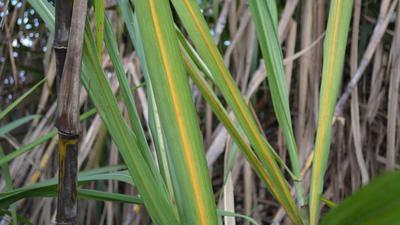Sugarcane Yellow Leaf Virus
Sugarcane Yellow Leaf Virus
Virus
In a Nutshell
- Yellowing of leaf midrib.
- Drying of youngest leaves.
- Stunted cane growth.
Can also be found in
Symptoms
Infection by Sugarcane yellow leaf virus causes severe symptoms including stunted cane growth, discoloration of leaves, and bunchy appearance of the plant. The yellowing of the leaf midrib on the lower side of the leaf appears on leaves 3 to 6 counting down from the top expanding spindle leaf. Yellowing expands out from the leaf midrib into the leaf blade as the season progresses until a general yellowing of the leaves can be observed from a distance. It is most noticeable in mature cane. Under severe infection, the spindle dries along with the leaves and the top gets a bunchy appearance. Sometimes a reddish discoloration can be observed. In mature cane, the disease will spread heavily and is identifiable from afar. It should be noted that symptoms could also be related to other factors as plant stress, insect damage or water deficiency.
Recommendations

Organic Control
Control of aphid populations is essential to control the transmission of the virus. Check the lower side of the leaves for aphids and, if found, treat immediately with insecticidal soap, neem oil or pyrethroid-based organic products. Predators feeding on aphids can also be used.

Chemical Control
Always consider an integrated approach with preventive measures and biological treatments, if available. You can prevent secondary transmission by insect vectors by applying Malathion @ 0.1% or Dimecron @ 0.2%. Two applications of malathion @ 1.5 kg/ha should be sprayed twice at a monthly interval after detrashing of dry leaves. Carbofuran @ 2 kg/ha can be used for soil applications.
What caused it?
Symptoms are either caused by the Sugarcane yellow leaf virus, which is transmitted secondarily by aphids (Melanaphis sacchari and Rhopalosiphum maidis) or the Sugarcane yellow leaf phytoplasma (SCYLP) which in turn is transmitted by leafhoppers. It is primarily transmitted through infected seed canes and not transmitted mechanically. Other crops such as wheat, barley, sorghum and oats are also susceptible to the disease but are only affected when sugarcane is being cultivated nearby. The disease is most noticeable in mature cane during dry weather conditions until the end of harvest.
Preventive Measures
- Use only disease-free seed material and plant resistant varieties, if available.
- By planting your seeds first in a nursery and later transplanting them to your field will contribute to avoiding the disease.
- Use yellow sticky traps for the control of aphid vector.
- Strip off mature leaves regularly, as aphids prefer to colonize those more often.



